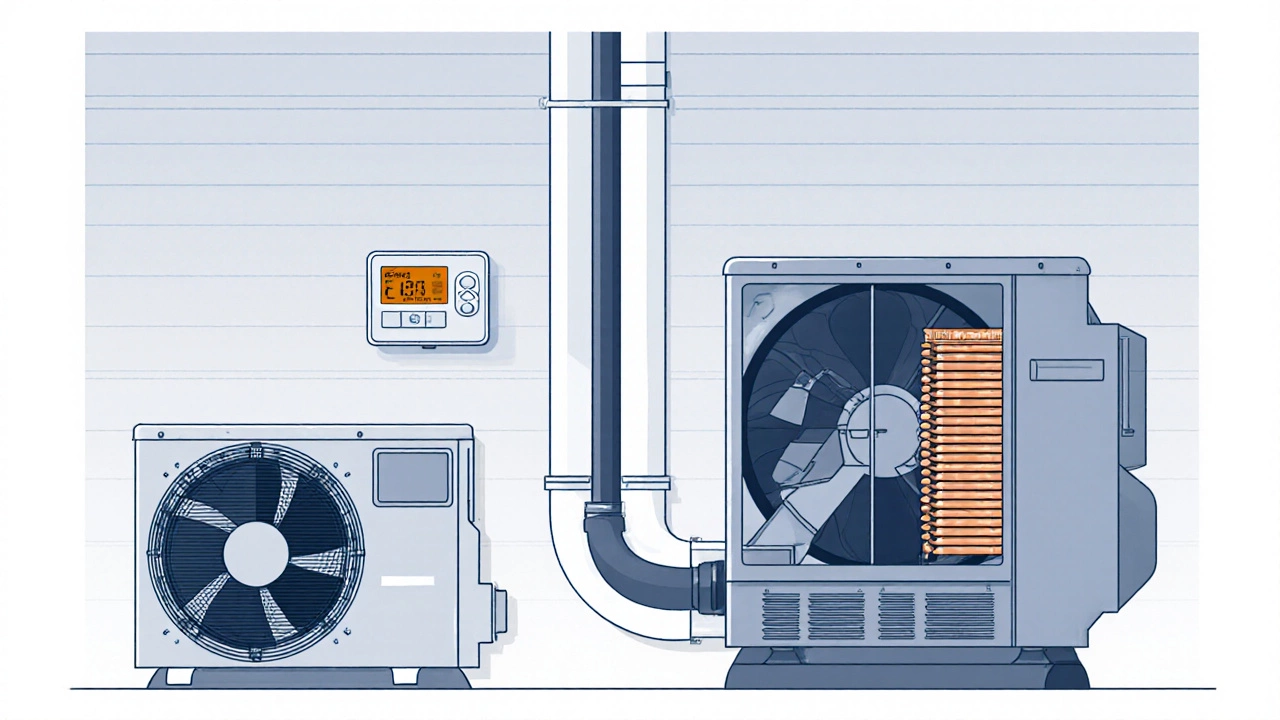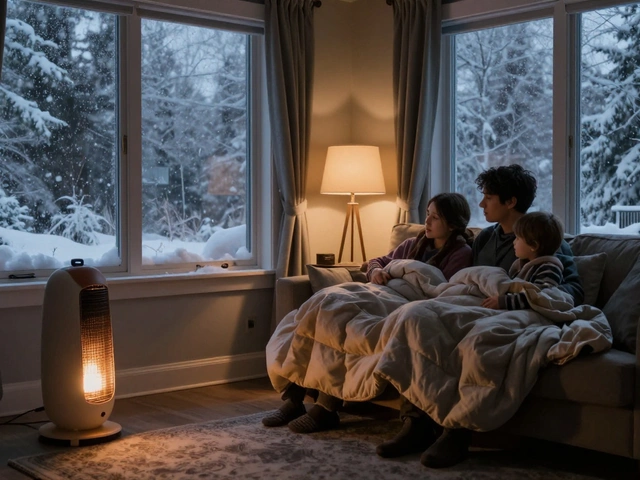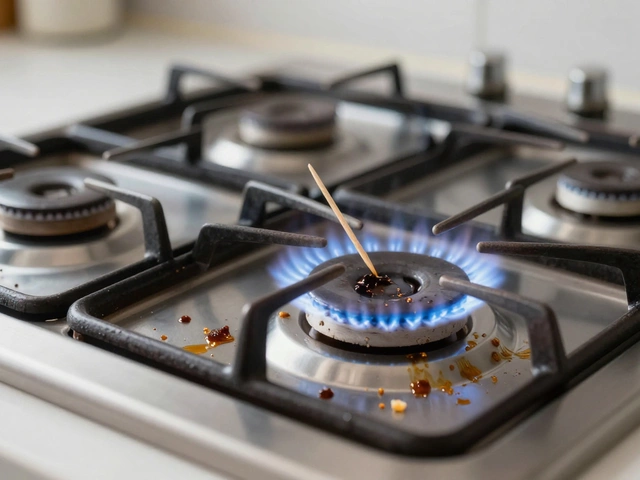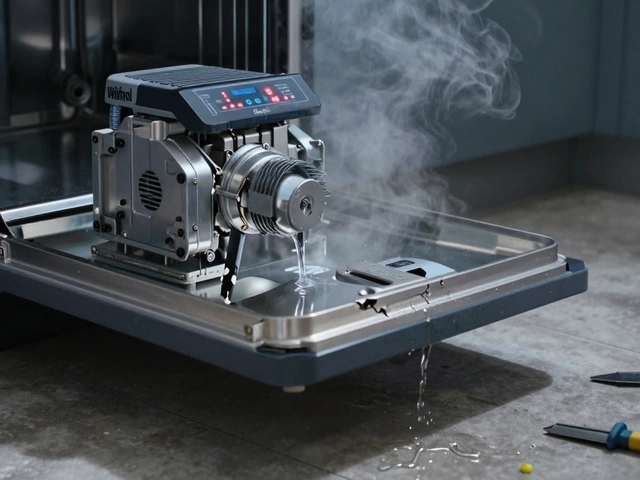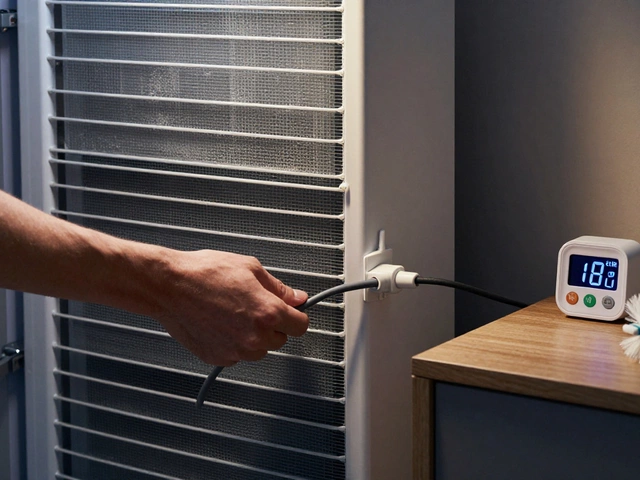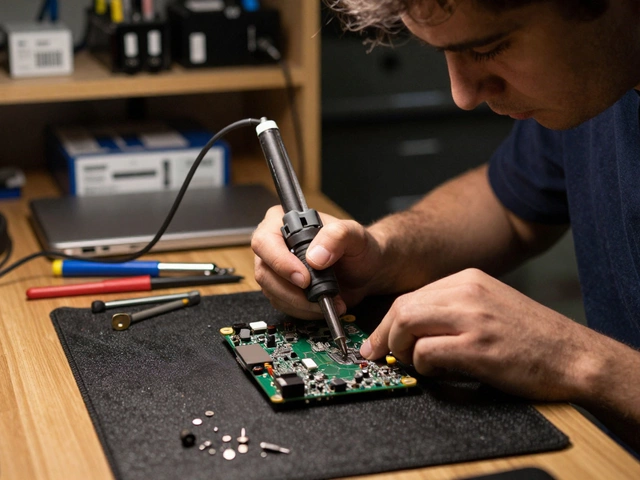Heat Pump Temperature Difference Calculator
Measure the air temperature at your return register (where air enters the system) and the temperature of the air coming out of your vents (supply air). In heating mode, a healthy heat pump should raise the air temperature by 20-30°F. Anything less may indicate a refrigerant issue.
Results
Key Takeaways
- Most issues show up as odd noises, reduced heating/cooling output, or ice on the outdoor unit.
- You can safely test thermostat settings, airflow, and basic electrical connections before calling a tech.
- Regular filter changes and coil cleaning prevent many common failures.
- If you notice error codes, strange smells, or water leaks, schedule professional service right away.
- Understanding the main components - compressor, thermostat, and refrigerant - makes diagnosis far easier.
What a Heat Pump Actually Does
When your home’s temperature swings unexpectedly, the culprit is often a heat pump a heating and cooling system that moves heat from one place to another instead of creating it by burning fuel. It works by circulating a refrigerant through a closed loop, absorbing heat outdoors in winter and rejecting it indoors in summer. The key parts are the outdoor unit the housing that contains the compressor, fan, and coils, the indoor air handler with its fan moves conditioned air through your ductwork, the thermostat the control panel that tells the system when to heat or cool, and the circulating refrigerant a chemical fluid that changes phase to move heat. If any of these components fail, the whole system feels the impact.
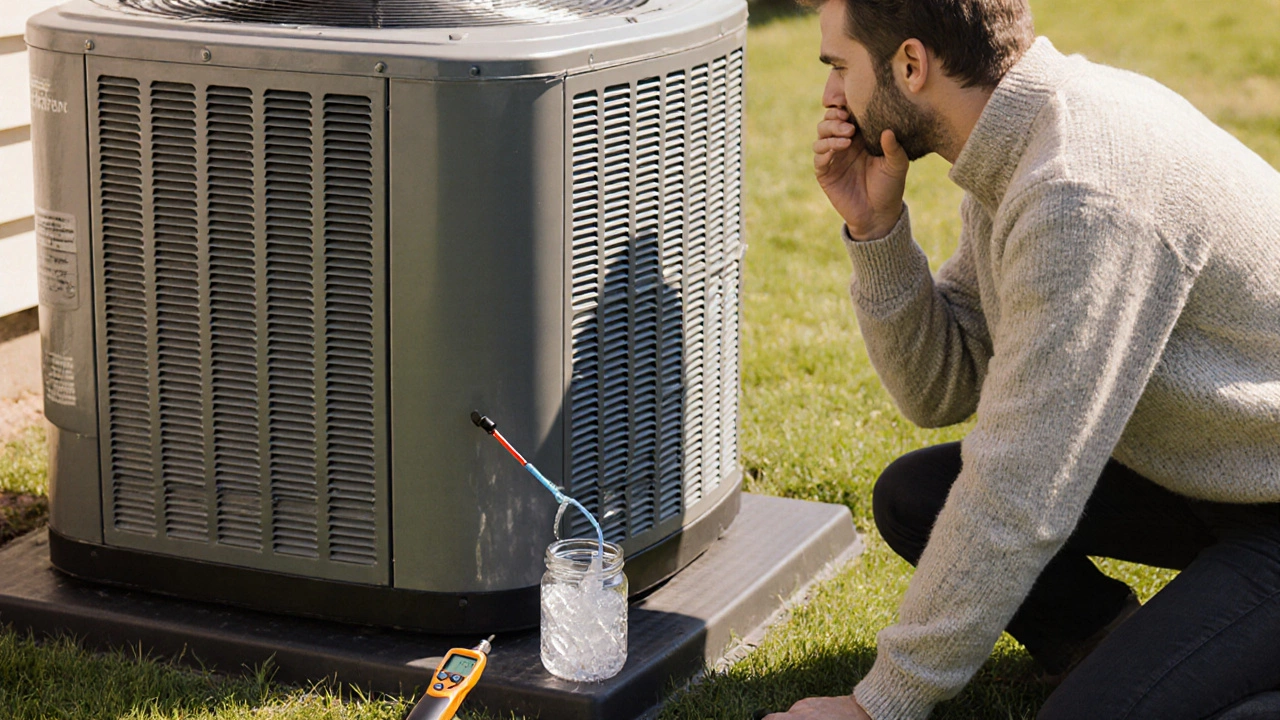
Common Warning Signs of a heat pump malfunction
Before you grab a screwdriver, listen for these red flags:
- Strange noises: squealing, grinding, or rattling often point to a failing compressor or loose fan blades.
- Reduced output: if rooms stay cool in winter or warm in summer, the refrigerant charge might be low or a valve is stuck.
- Ice buildup: frost on the outdoor coil means airflow is blocked or the defrost cycle isn’t working.
- Frequent short cycles: the system turns on and off every few minutes, indicating a bad pressure switch or thermostat mis‑reading.
- Water leaks: condensation that pools under the unit can signal a clogged drain line or a cracked indoor coil.
- Foul smells: burning plastic, ozone, or refrigerant odors should never be ignored.
Step‑by‑Step DIY Diagnosis
- Check thermostat settings. Make sure the mode is set to "Heat" or "Cool" as needed, the fan is on "Auto", and the temperature setpoint is at least 5°F away from the current room temperature. A simple mis‑setting can mimic a failure.
- Listen for abnormal sounds. Stand near the outdoor unit. A high‑pitched squeal often means a motor bearing needs lubrication; a metallic grinding suggests the compressor is seizing.
- Inspect the outdoor coil. Turn off power at the breaker, remove any debris, and look for ice or dirt. A clean coil should be free of snow, leaves, or heavy grime; ice patches larger than a few inches indicate airflow restriction.
- Verify airflow. Inside, check that the return registers are not blocked by furniture or curtains. Replace or clean the indoor air filter; a clogged filter forces the system to overwork and can trigger a short cycle.
- Measure temperature difference. Using a simple infrared thermometer, record the supply air temperature coming out of the vents and the return air temperature. In heating mode, a healthy heat pump should raise the air temperature by 20‑30°F. Anything less suggests a refrigerant issue.
- Look for error codes. Many modern units have an LED flash pattern. Consult the owner's manual (usually found on the indoor blower compartment) to decode the pattern. Common codes include "E1" for sensor failure or "E3" for low refrigerant pressure.
- Check the condensate drain. Use a wet‑dry vacuum on the drain line to clear any blockage. Slow drainage can cause water to back up and leak onto flooring.
- Observe the defrost cycle. In winter, the outdoor unit should periodically reverse and briefly warm the coil. If it never does, the defrost thermostat or timer may be dead.
If any step reveals obvious damage-broken fan blades, cracked coils, or burnt wiring-stop and call a licensed HVAC technician. DIY work beyond filter changes and visual inspections can be hazardous.
When to Call a Professional
- Repeated short cycling after you’ve verified thermostat settings.
- Ice that won’t melt after a full defrost cycle.
- Visible refrigerant leaks (oil‑colored spots near connections).
- Electrical smells or tripping breakers.
- Any error code you can’t decode or that persists after a power reset.
Certified technicians have the tools to safely recover refrigerant, test motor amps, and replace faulty pressure switches or capacitors.
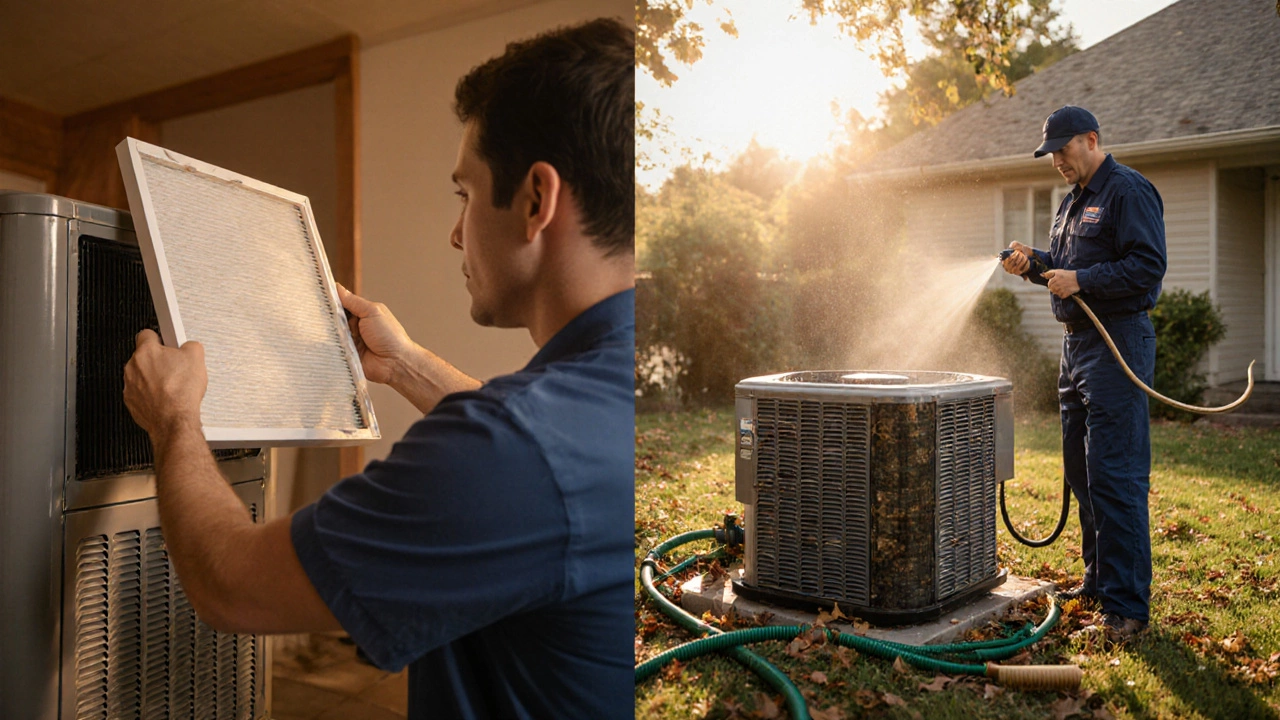
Preventive Maintenance Tips
- Replace indoor air filters every 30days during high‑use months.
- Clear leaves and debris from around the outdoor unit to maintain at least 2ft of clearance.
- Coil cleaning: once a year, gently spray the outdoor coil with a low‑pressure hose while the fan is off to remove buildup.
- Schedule a professional tune‑up before the heating season; they can check refrigerant charge, electrical connections, and calibrate the thermostat.
- Run the system in “fan‑only” mode for 10minutes each month to keep the indoor fan lubricated.
Quick Troubleshooting Table
| Aspect | Normal | Problem Indicator |
|---|---|---|
| Noise | Soft hum, occasional fan click | Squealing, grinding, rattling |
| Air temperature lift | +20‑30°F (heating) or -15‑20°F (cooling) | Lift < 10°F, uneven rooms |
| Outdoor coil | Clear, no ice | Ice patches, frost exceeding 1inch |
| Cycle length | Runs 5‑15min per stage | Cycles < 2min repeatedly |
| Condensate | Drains away cleanly | Leaking water, clogged drain line |
Frequently Asked Questions
Why does my heat pump freeze up in the middle of winter?
Freezing usually means airflow is restricted or the defrost timer failed. Check that the outdoor unit isn’t blocked by snow, and verify the indoor filter isn’t clogged. If the coil still ice up after a full defrost cycle, call a technician to inspect the pressure switch and refrigerant level.
Can I recharge the refrigerant myself?
No. Handling refrigerant requires certification and special equipment. Adding the wrong amount can damage the compressor and is illegal in many regions.
My thermostat shows “E1” - what does that mean?
"E1" most commonly signals a failed indoor temperature sensor. Power‑cycle the heat pump, then replace the sensor if the code returns.
How often should I schedule professional service?
A yearly tune‑up before the heating season keeps the compressor, refrigerant charge, and electrical components in good shape. Many contractors also offer a summer check‑up for cooling efficiency.
Is a noisy indoor fan a sign the whole system will fail?
Not necessarily, but it’s a warning. Dirt on the fan blades or a loose motor mount can cause rattling. Clean the fan and tighten any loose screws; if the noise persists, replace the fan motor before it damages the compressor.
